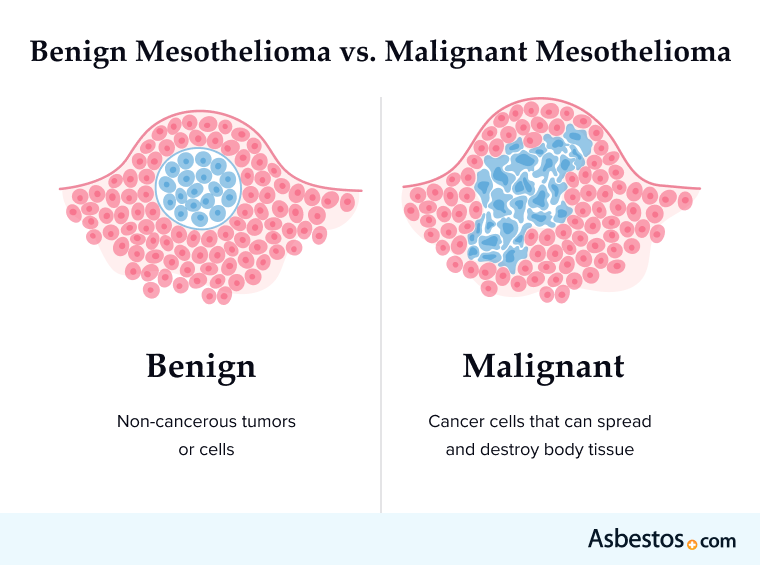Benign Mesothelioma
Benign mesothelioma, unlike malignant mesothelioma, is noncancerous. These growths, or tumors, aren't considered life-threatening. They haven't spread, or metastasized, to other parts of the body and can be removed with surgery.

What Is Benign Mesothelioma?
Benign mesothelioma is a noncancerous growth that develops in the thin tissue that protects your lungs, heart, stomach and testes. Its tumors don’t spread, and they grow slowly. Tumors also tend to form a singular mass.
Key Facts About Benign Mesothelioma
- Benign mesothelioma accounts for 10% of mesothelioma cases.
- The incidence rate for the multicystic peritoneal type is under 1%.
- Benign mesothelioma is more common in women in their 20s to 40s.
- Men who develop benign mesothelioma have a mean age of 67.
A correct diagnosis and treatment plan are vital. They lead to the best outcomes in benign mesothelioma cases. Most people with benign mesothelioma can be treated and will fully recover. However, if tumors return they may become malignant. For this reason, doctors must continue to watch for new tumors.
Benign Mesothelioma vs. Malignant Mesothelioma
Benign mesothelioma tumors don’t spread like malignant malignant tumors. Benign mesothelioma tumors grow at a slower rate than the many tumor nodules seen in malignant mesothelioma cases. Benign tumors, unlike malignant ones, respond well to treatment. That’s good news for patients.

Benign and malignant mesothelioma have some symptoms in common. Benign tumors can still cause discomfort. Abdominal pain and shortness of breath are symptoms of both. However, weight loss is a common malignant symptom. In contrast, those with benign tumors tend to gain weight. There are different types of both benign and malignant mesothelioma. Each benign type is rarer than malignant mesothelioma.
Types of Benign Mesothelioma
There are several benign mesothelioma types. The tumors’ cell characteristics define each. The most common type is benign multicystic mesothelioma. But it has fewer than 200 reported cases. Well-differentiated papillary mesothelioma is even rarer. There are only 180 documented cases.
Benign Mesothelioma Types
- Adenomatoid Tumor: AT is a subtype of epithelial mesothelioma. It most often affects the uterus wall and the tunica vaginalis. It’s rare for this type to develop in the pleura.
- Benign Multicystic Peritoneal Mesothelioma: BMPM occurs in the peritoneal cavity, most often in the pelvis. It mainly affects young and middle-aged women. It sometimes occurs in women with a history of abdominal surgery.
- Localized Fibrous Tumor: LFT affects the surface of mesothelial cells in the pleura. It can also occur in the pericardium, tunica vaginalis and peritoneum. About 50% of patients have no symptoms. When they occur, they include a cough, pain and breathlessness.
- Well-Differentiated Papillary Tumor: WDPT is usually benign. But, there are recorded cases of malignant cells mixed with benign ones. Most cases occur in the peritoneum of women 30 to 40 years of age.
Of these benign tumors, WDPMT is most likely to become malignant. People with all benign types are monitored after treatment. Doctors watch for signs of the tumors returning.

Symptoms of Benign Mesothelioma
Benign mesothelioma in the abdomen may cause swelling and pain. Palpable masses within the abdomen or pelvis may be present. Benign and malignant mesothelioma share similar symptoms. Benign tumors can grow large enough to harm nearby tissues and organs. Mesothelioma symptoms vary depending on the affected organ. They may affect tissues in the chest, abdomen or pelvis.
Common Benign Mesothelioma Symptoms
- Abdominal pain
- Chest pain
- Chronic cough
- Fluid buildup
- Palpable masses
- Shortness of breath
- Weight gain
Benign pleural tumors may cause low blood sugar. Rarely, they may cause seizures or coma. These are also symptoms of malignant pleural mesothelioma. Other symptoms are fever, night sweats and weight loss.Symptoms of benign mesothelioma may be unclear in some cases. A 2021 report in the Annals of Medicine and Surgery noted a 25-year-old woman with unusual symptoms. She had constipation, a strong urge to urinate and irregular periods. This case study shows how hard it is to diagnose some benign mesotheliomas.
Diagnosing Benign Mesothelioma
To diagnose benign mesothelioma, doctors first do a physical exam. Then they record the patient’s full medical history. Blood tests, imaging scans and a biopsy are taken. The biopsy is key because it shows whether a tumor’s cells are benign or malignant.
Diagnostic Tools
- Biopsies: A biopsy collects a sample of cells for analysis under a microscope. Biopsies are the only way to confirm if a tumor is benign or malignant.
- Blood Tests: They may help detect if cancer is present.
- Imaging Scans: X-rays, CT scans, and MRIs may spot suspicious tissue. Imaging helps to find the location of potential tumors. This helps with biopsies and surgery.
A biopsy also shows the specific cell type that makes up the benign tumor. This information is helpful in assessing the risk of cancer. Some cells have a lower risk of turning into malignant mesothelioma.
How Is Benign Mesothelioma Treated?
Benign mesothelioma is primarily treated with surgery. Heated chemo may also treat tumors in the abdomen during surgery. This helps reduce the rate of recurrence. Postoperative systemic chemotherapy is generally not recommended.
Pleural cases are less likely to recur than peritoneal ones. About 3% of pleural cases recur, while about 50% recur in peritoneal cases without heated chemotherapy. About 80% percent of multicystic peritoneal patients stay disease free 10 years after HIPEC.
Treating Benign Pleural Mesothelioma
Thoracotomy treats benign pleural mesothelioma. This may involve the removal of a segment of the lung, a lobe or even the entire lung. However, removal of the entire lung is infrequent in benign cases. There are potential risks associated with surgery. The most common side effect of surgery is pleural effusion. A chest drain may be needed. Fluid buildup in the pleural spaces puts pressure on the lungs and heart.
Treating Benign Peritoneal Mesothelioma
Surgeons use cytoreductive surgery to remove benign peritoneal mesothelioma tumors in the abdomen. Heated chemotherapy follows the surgery. This combination has cut the recurrence rate to about 20%.
Laparotomy or laparoscopy was once commonly used. Unfortunately, the tumors often returned. This was especially the case for women. Women showed a recurrence rate of 40% to 50%, while men had a 33% recurrence rate after surgery.
What Is the Prognosis for Benign Mesothelioma?
The prognosis for benign mesothelioma is favorable. This is especially true if the tumors are fully removed with surgery. Benign mesothelioma doesn’t usually affect life expectancy. The disease responds well to surgical management. Most people can lead a full, unrestricted life after surgery.
Recurrences are common, and another surgery can help manage them. Doctors have found some risk factors for recurrence. Abdominal cases have a higher rate of recurrence. Not fully removing a tumor can also cause recurrence.
Unfortunately, there is a small risk the disease could turn malignant. A biopsy can tell if benign mesothelioma is now malignant. A malignant transformation will affect prognosis.
Common Questions About Benign Mesothelioma
- Is surgery always necessary for benign mesothelioma?
-
Surgery is the most common treatment. For those who don’t qualify for surgery, doctors use chemo. Radiation may also be used in some cases.
- Are there any long-term health risks with benign mesothelioma?
-
There is a possibility of recurrence. These tumors aren’t cancerous. But they can cause discomfort. There is a possibility they can develop into malignant tumors.
- Should benign mesothelioma patients make lifestyle changes?
-
It’s not clear if lifestyle changes reduce the risk of recurrence. It’s also unclear if lifestyle raises the risk of tumors turning malignant.
Smoking, for example, doesn’t directly cause mesothelioma. But it can affect the body’s response to asbestos.
Good overall health can help you heal better after surgery. This can reduce recovery time. Chemo and radiation can lower immunity. A healthy lifestyle can improve immunity. Diet and exercise can benefit the immune system.
- What follow-up is recommended after treatment?
-
Your doctor will likely schedule you for imaging scans. These screenings may be every 3 or 4 months at first. It’s important to check for recurrence.




